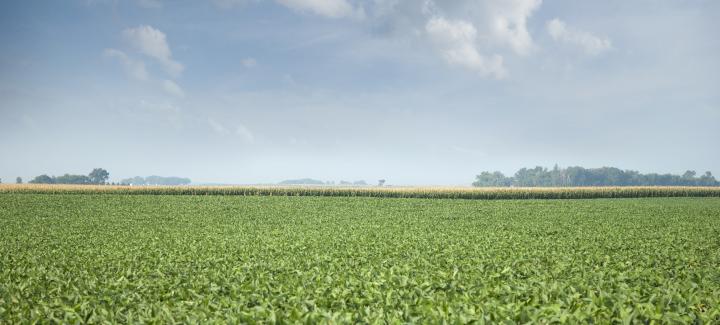
The USDA weekly crop progress report states that 47% of the U.S. corn crop has reached the silking stage. Of the 18 states that planted 92% of the 2022 corn acreage, corn crop conditions are listed as 11% excellent, 46% good, 30% fair, 9% poor and 4% very poor. The weekly crop progress report notes that 56% of soybeans have reached the blooming stage and 20% have set pods. Of the 18 states that planted 95% of the 2022 soybean acreage, soybean crop conditions are listed as 8% excellent, 47% good, 32% fair, 9% poor and 4% very poor. From the Delta South to Nebraska, Illinois, and North and South Dakota, here's what Stine regional sales agronomists (RSAs) are reporting from their territories.
Paul Galm, Region 3 (southern South Dakota)
Region 3 crop progress is normal to slightly ahead of normal. Corn is in the early to mid-pollination range. Soybeans are in the R1 to R2 stages.
Soil moisture throughout most of the region continues to track from below normal to much below normal. Progress in soil moisture has been made, however, in recent weeks. Crops are catching timely rains, and most growers are optimistic about improved crop conditions and yields over last season.
The Enlist E3® technology is working very well despite the dry conditions, with most growers reporting very good to excellent weed control. The cleanest fields are those where a good pre-emerge or burndown program was implemented ahead of post applications.
Stine corn hybrids with good to excellent drought ratings are handling the conditions very well. With the abundant GDU accumulation, we anticipate another good performance year, with elite Stine hybrids in the mid- to full-season maturities looking best in plots and growers’ fields. At least one more timely rain in the next few weeks will be necessary for optimum corn yields.
Chad Kuehl, Region 5 (southeast Nebraska)
A good portion of Region 5 is in a drought, but we’ve started to catch some rains here the past few weeks. With that always comes the spotty hailstorms that have taken out some corn and soybean fields. These late rains have really helped the soybeans start canopying the row; it’s a night and day difference from a few weeks ago. A good portion of our corn is starting to or has pollinated. So far, Stine 9817-30 and 9818-32N look really good, as well as multiple experimental hybrids in our product development plots.
Kevin Krabel, Region 13 (central Illinois)
After an extremely hot and dry spell in June, we finally got some much-needed rain across Region 13. Most corn is tasseling, with the exception of some late planted crops. Soybeans are also flowering and have canopied for the most part. Due to the lack of rain early and then being too wet to get in the field to spray, we are seeing some increased weed pressure in the region. Growers are having to get back in the field and spray a second or third time in some instances to get the weeds beaten back. Time will tell on how everything turns out for this year’s crops.
Kevin Ryan, Region 14 (Arkansas and Louisiana)
Corn has reached black layer most everywhere, and we are probably shutting off irrigation water after this week. Louisiana has many corn acres that will begin harvest next week. We look forward to above average yields.
Soybeans are anywhere from beginning pod set to full pod set. They look really good!
The timely planting this spring is helping us to an early harvest. It’s time to keep our eye out for grain moisture levels and weather forecasts. The last thing we need is hurricane rains for what appears to be a very good crop.
Michelle Nelson, Region 36 (southern and central North Dakota)
Things look pretty good in North Dakota. We recently received some welcomed rain but could still use some more moisture. The earliest planted corn is just starting to tassel.
We are seeing a bit more IDC in the soybeans because of the dry conditions. The recent rains have helped, and most have rebounded. Overall, things look good. Hopefully the weather continues to cooperate for us!
Stay tuned to next week’s edition of Stine Weekly for part 2 of our crop progress report. In the meantime, if you have any questions related to our products or need any agronomic advice, please don’t hesitate to reach out to your local Stine sales rep or RSA.
Related Articles
-

Stine® to offer Syngenta’s Victrato® soybean seed treatment in 2026
December 2025 in Agronomy
-

Use Stine’s XP® seed treatments to prevent early injury to your crops
December 2025 in Agronomy
-

Understanding Stine’s enhanced oil profile soybeans
December 2025 in Agronomy
-

Soil sampling sets the stage for spring
November 2025 in Agronomy



